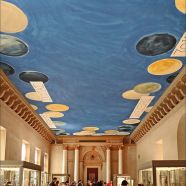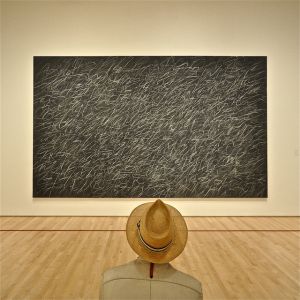
The Ceiling of Cy Twombly (The Louvre), Photo by Jean-Pierre Dalbéra
Share This
Print This
Email This
Remembering Cy Twombly
Cy Twombly’s paintings are perhaps best understood as a type of visual poetry. Fragmented, discontinuous, yet rich in information and deeply evocative, they speak to us in a voice beyond the everyday that can be at once whimsical and epic. Twombly came of age as an artist in that transitional moment in the 1950s when the primacy of the Abstract Expressionism of the New York School was absolute, yet its freshness and authority were gradually being eroded by new ideas from younger artists mining different ideas and different worlds from a decidedly different point of view. Three important new voices that became a historical point of reference for the new art of the late 1950s and 1960s were all from below the Mason-Dixon Line: Jasper Johns from rural South Carolina, Robert Rauschenberg from Port Arthur, Texas, and Cy Twombly from Lexington, Virginia. The slow “Velvet Aesthetic Revolution” that emanated from the work of these, and other, artists not formed by the Great Depression and the Second World War, was clearly influenced by the ideas and ideals of American Abstract Expressionist Painting, but also engaged and connected in a direct way that was erosive to the formalist detachment typical of the previous generation. To use Rauschenberg’s phrase, the younger artists were working in “the gap between art and life,” and embracing the detritus of the everyday and the quotidian in a way that transformed both the substance and content of their work. Johns’ targets, flags, and visual clichés and Rauschenberg’s use of found objects from the beach and the street inserted reality in their work in an explicitly literal way. As the new art edged in the direction of the new realism of Pop Art, Twombly’s playful abstract painting remained aloof from this trend, yet was in subtle opposition to the claims and intent of the Abstract Expressionists through the pursuit of a free-ranging almost primal, radically intuitive approach to line and composition, driven by a growing concern with poetic, historical, and mythic content.
Born in Lexington, Virginia, Cy Twombly’s first love was the landscape, and in his words the beauty of the Virginia landscape “had it all.” Travel was important to his formative years, especially his trips to Europe and North Africa, and in his mature years his life was anchored between the worlds of Lexington, Virginia, and Rome, Italy. As Twombly often pointed out, both of these worlds, while far apart, are both southern, and this distinction of being from the American South by birth and Southern Europe by choice clearly set him on a singular path and working at a different pace from most of his contemporaries. Knowledgeable of, but out of sync with the New York art world, Twombly’s work initially elicited highly polarized responses, and it took the globalization of the art world in the 1980s to be fully understood in a larger context than the New York avant-garde. In his essay for the 1994 Museum of Modern Art retrospective, Kirk Varnedoe, himself a southerner, identified factors that linked the American and European souths that constituted the context of Twombly’s life and work; “a Neoclassical architectural heritage . . . a honeyed ease with spoken language, a rich literary tradition, a certain sensual languor, and a lingering romance with fallen grandeur.” To this, I might add a different sense of sun-drenched time, one that is slower and grounded in the continuity of the past and the present, and a tolerance and encouragement of individuality and personal eccentricity that is often at odds with contemporary norms.
Although initially seen as a continuation of mid-century American abstraction based on intuitively composed gestural marks in a free-flowing field, Twombly’s work originated from other sources and meant something different as well. Like his predecessor and influence Arshile Gorky, Twombly’s paintings are singular bridges between styles, eras, and worlds that are above all works of sensibility. By the late ’50s he was already post-gestural, but also heading in the direction of a conceptual approach that, in its embrace of the past, and mixture of abstract line, color, and text (he would later use words scrawled across the surface of his canvases) looked forward to a wave of younger European artists that came to prominence in the 1980s.
It was Twombly’s embrace of history and the epic that seemed to cause the most confusion and consternation among his American peers. Whether it was a lingering suspicion about the influence of his expatriate status or simply the shortsighted view from the island of Manhattan, Twombly’s career went into an American eclipse in the mid 1960s. His 1964 exhibition at the Leo Castelli Gallery in New York City was met with barbed criticism in the art press, exemplified by the comment of the minimalist sculptor Donald Judd, himself no admirer of painting or European sensibilities, who claimed that Twombly’s new works were few lines and scribbles with nothing to them at all. With his reputation at home bruised and his American career in doubt, he turned to Europe, where he found a more receptive audience to his work, increasingly inspired by the glories and tragedies of the ancient world.
The broader appreciation of Cy Twombly’s conceptual approach to abstract painting was delayed as others caught up with his mythic vision of poetic fragmentation. One important factor was the transformation of the art world from being Ameri-centric in the 1980s and the emergence of European artists exploring their own past and the present on their own terms. Working under the generalized term Neo-Expressionism, this group of international artists, along with a few of their fellow European predecessors, were looking at an approach to making art rooted in history and myth that had been at the center of Twombly’s work for almost two decades. Suddenly his work could be appreciated for being both post-gestural and pre-Neo Expressive, as he was himself a part of the history of art that was a lasting influence on the younger generation of artists searching for new models of possibilities in a pluralistic world.
By the time of his death this year at 83, Cy Twombly had long been celebrated as one of the old masters of modern art and one of our greatest living artists. In 1989 the Philadelphia Museum of Art opened several permanent galleries to house his cycle based on The Iliad, and in 1995 the Menil Collection opened a pavilion designed by Twombly and the Italian architect Renzo Piano dedicated exclusively to Twombly’s paintings and sculpture. In an ongoing dialogue with the past presented in provocative juxtapositions, in 2011 the Dulwich Picture Gallery in London organized a two-person exhibition pairing Twombly with the seventeenth-century French Neoclassical painter Nicolas Poussin, and in 2012 the Tate Gallery in London mounted an exhibition of his work alongside that of the British artist J. M. W. Turner and the French Impressionist Claude Monet. In 2010 Twombly executed the unusual commission of a large ceiling painting celebrating seven classical Greek sculptors in the Salle des Bronzes at the Louvre, a first for an American artist.
In spite of all of the celebrated acclaim, one of Twombly’s greatest legacies may be his deep and continuing influence on the creative work of two generations of younger artists from across the globe. For this, we may soon be adding another term to the history of art. In the seventeenth century Poussin was so influential that his followers were named the Poussinistes, or the little Poussins. In our time we need to recognize a range of artists who may clearly be identified as Twomblyesque.
*For more information about this photo, please visit: http://www.flickr.com/photos/7593077@N03/6200362400/in/photostream/







